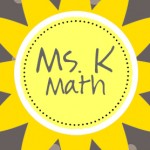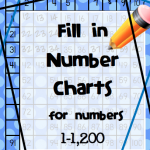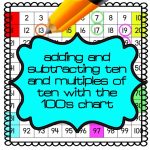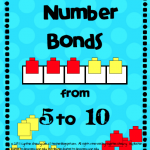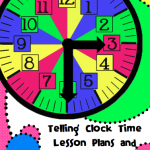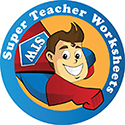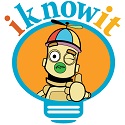Do You Need an Idea for a Festive Christmas Door?
My colleague next door felt that I had given him a little competition with my Grapes of Math door earlier this year :), so he has festively decorated his door for each season this year. This colleague exudes artistic talent and can construct just about anything with some colored bulletin board paper and cardboard. This is his “gift” to everyone in the hall. I just love it–and all out of bulletin board paper too!
Have A Few Extra Minutes? Play SQUAT!
To practice math facts, spelling words, or any other quick answer type learning, you can play Squat. To play Squat, two students from two different teams approach the board. The teacher calls out a fact or a spelling word. The two students at the board race to answer the question correctly and then they squat when they think they have the correct answer. If they are correct they earn a point for their team.
When I have played this, I usually split my class into two teams. Different students on the teams take turns to be at the board to earn their team points. Team points can be taken away from students who aren’t waiting quietly or who blurt out an answer when it isn’t their turn. Students love this game and will beg to play it after you have played once. If you have some extra time (heh, heh, who has that?!) during a spot in your day, this is a fun way to reinforce skills or fill time.
How Can You Get Your Classroom Cleaned Up Fast?
Does this sound familiar? You are surprised when you look up to see the clock shows that you only have 9 minutes to pass out end of the day papers, close your lesson, to have children to clean their desks, to have children get their backpacks, and line up in an orderly fashion. You look at the floor and think the custodian will groan will he comes to your room. You think you don’t have any time to have the children clean the classroom floor, but that’s because you have never played “I Spy” the trash version! I learned this antic from a P.E. teacher.
The teacher says, “The person who gets the piece of trash I spy gets_______ (you fill in the blank–a treat or prize?). You have 30 (etc.) seconds. Go!”
Students then frantically look for pieces of trash and try to figure out what piece of trash you see. Don’t stop the game until the classroom floor looks as clean as you desire. Students will ask you if they found the piece of trash you spied, but don’t stop the game until you get the floor clean. Sometimes I tell students that I spied another piece of trash if I want to spur on more meticulous trash gathering. If you have a group of children that aren’t well managed this game can become rambunctious, but I have found that if you have high expectations and procedures with the rest of your day students will stay focused on trash finding. This game is fun for both the students and the teacher.
Where Can You Find Model Common Core Lesson Videos?
Today I was at a professional meeting in which we were working on building a pacing guide for the 3rd-5th common core standards. The presenter for our meeting showed us this fabulous website which has cutting edge materials pertinent to the common core standards. There are a few sample tasks for each grade level with rubrics. Not only are there tasks, but there are videos of teachers, coaches, and principals discussing student thinking before and after a video taped lesson as well as teachers teaching lessons. If you just want to view a part of the video sessions, they are broken up into parts: before the lesson, the different sections of the lesson, and the debriefing after the lesson. I really enjoyed hearing the teachers discuss why and how they were planning because I had a sense of the fact that I am not alone in the problems I am having with children’s mathematical thinking. These problems are found across our country–the one aspect about the second grade video that grabbed my attention is that this second grade teacher was discussing how her students see a word problem and want to immediately add the two numbers within the problem even though the problem may not be an addition problem. All in all this website is a fabulous find especially if you are responsible for doing any professional learning meetings at your school–or even if you just want to learn yourself. (FYI: As of the time of this post, there are a lot more upper grade videos than elementary, but the site is worth a visit no matter what grade you teach.)
Using Wiki Spaces to Further Math Instruction…
I found this wiki space that has student math movies on it. Students explain what they have learned about a math concept on a video. The wiki definitely gave me some ideas. There are many math topics listed. My favorite is the spoof of the Brady Bunch theme song and opening video, but instead “The Avery Bunch” explaining fractions. Of course, Mr. Avery is their teacher. I really like the idea of the students demonstrating their learning in video form because they have to be knowledgeable enough to explain their learning in detail. We all know that increases learning–teaching others–according to Glasser’s theory of learning!
Project Based Learning–Where Do You Start?
With the common core standards making their grand entrance this year, project based learning is quickly becoming a new buzz word. I myself understand the concept of project based learning, but have seen very few examples of students real-world projects. Seeing few examples makes project based learning seem vague, and so I was very excited to stumble upon this fascinating website http://pbl-online.org/ about project based learning. When you visit the site, you will find information about what project based learning is, a collaborative community of teachers developing and sharing projects (you will have to create an account for this), and videos of students and teachers working through and planning projects etc.
Do Government Monopolies Have a Child’s Best Interests at Heart?
In John Stossel’s recent report on public education, he conveys how the government school monopoly does not trust education to the free market even though the free market has made everything else in America great. Opposing teacher’s unions argue that the parents aren’t real ‘customers’ because they aren’t knowledgeable enough about education. Stossel’s report implies that if we trust public education to the teachers unions as we have before we will get more of the same–increased funding yet no results shown in improving student achievement. Teacher’s unions continue to advocate that they are ‘for’ improving education, yet some teacher’s unions are explicit in their thoughts such as one teacher’s union leader who stated, “When school children start paying union dues, that’s when I’ll start representing the interests of school children.”
To read more click here.
Free Printable Number Discs
With second grade right now, students are doing a lot of place value activities and are using base ten blocks as well as math discs. I made these printable math discs for the kids to represent and compare numbers. If you would like to use them they are available for a download. I am copying the ones on white, the tens on red, and the hundreds on orange paper to represent the math discs. Students are going to cut these out and glue them down to represent a number.
How Do You Motivate Students to Learn Their Math Facts?
I am trying something new this year to help motivate students to learn their math facts. I heard about doing Math Wars from another math coach. Each class will give themselves a name for a team. The team could even be alliterated for more fun. For example, Mr. Bowers Brains or Ms. Elwick’s Elephants. Having the students take ownership in what they name themselves promotes more motivation to work towards the goal of learning their facts.
Classes challenge other classes to beat them on their fact races. Grade levels can challenge other grade levels too. For the first Math War at my school, I have decided to just have classes compete with other classes in the same grade. To determine the winner, I am calculating the total amount of items that are correct and taking a class average. This way all of the students are working towards doing better, and there are no tears or frustrations if all of them are not answered. Students will be answering all of the facts in the race, and I will give them two seconds per problem. If there are 60 problems, then students will have 2 minutes to answer all of their problems For the next war classes may compete outside their grade level; 4th graders may challenge 5th graders, for example. One of the teachers at my school suggested putting up schedules like when football games are played. So working with this suggestion, I have placed posters on the walls to add to the anticipation of triumphing over another team. This has added to student motivation since I hear students saying that “we are gonna beat Ms.____’s class”.
For trophies I tried to think of something that would reflect the idea of math and that I could spray paint gold. After brainstorming with several colleagues, someone suggested an abacus. So now I have the GOLDEN ABACUS (angels singing in the background). The golden abacus will be traveling to the winning classes and will go to follow the next champion. I bought several abacuses so that each winning class could have an abacus for each WAR.
Need an Engaging Way to Introduce Equations?
The first grade teachers at school absolutely love introducing subtraction and addition number sentences to their kids using the book Ten Flashing Fireflies by Philemon Sturges. I discovered this book in a lesson recorded in a Math Solutions book entitled Minilessons for Math Practice K-2. There is also a similar lesson (I think…not positive) in another Math Solutions book entitled Teaching Arithmetic. In the lesson students model the action of gathering fireflies into a jar using snap cubes. In the book there is a jar printable to use or the lesson suggests using a sheet of blue construction paper to represent the night sky. Not only is this lesson good for introducing the action of subtraction and addition, but it is also good for discussing one more and one less. Because this is such a beloved book that builds a great foundation for addition and subtraction, I worked on building this free SMART Board lesson to accompany the book this weekend, and so here is an example of this lesson. Just click to download the SMART Board lesson for free.
